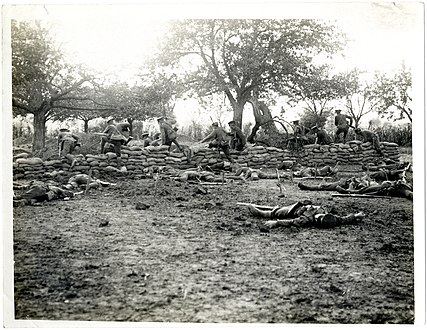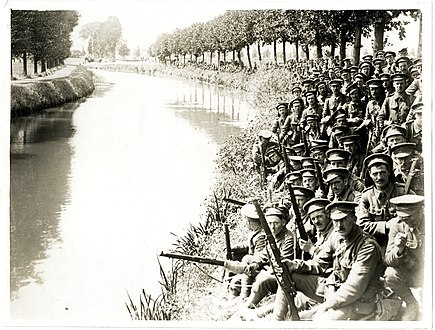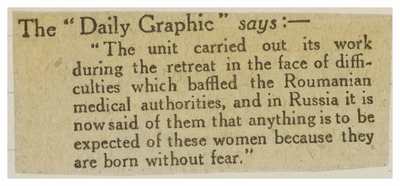Europeana/1914-18/Wikimedia UK
Overview
[edit]
Registered as a charity in November 2011, Wikimedia UK's outreach activities to the public and academics escalated at a time when many organisations were commemorating the First World War.
This gave us the opportunity to incorporate WWI-related events in many of our projects. This is particularly evident in our residencies. The approach to these events has progressed over time, along with the approach to our impact as an organisation. Initially the focus was fine grain, pinpointing aspects of Wikipedia which could be improved. Gradually the focus widened to include media files, and then focus on how these might be used on Wikipedia. All the while, editathons have been a useful tool getting the public to engage with WWI and Wikimedia.
Key partners
[edit]JISC
[edit]Wikimedia UK's first editathon on the theme of WWI was held on 16 June 2012 and organised in partnership with JISC. As a preliminary, JISC identified strategy, medicine, and global impact as key areas in which digital coverage of WWI is typically lacking (universally rather than specifically Wikipedia). Academics made suggestions for articles which need improvement, which directly led to the improvement of articles on shell shock and Ireland during the war. Around 30 people made some edits, improving around as many articles.
 British Library
British Library
[edit]With 150 million catalogued items in its collection, the British Library is the second largest library in the world. It has contributed 10,000 digitised items to the Europeana 1914–18 project, and established a site for people researching the war and its impact. Between May 2012 and April 2013 the Library hosted a Wikimedian in Residence. This was Wikimedia UK's first venture into residencies, and from an early stage there was an emphasis on giving library staff the skills to edit Wikipedia, uploading content to Wikimedia Commons, and holding editathons as outreach events.
The residency involved uploading digitised content to Wikimedia Commons, including images from WWI. To re-use these images the Resident organised an editathon for June 2013. The event attracted experienced Wikipedia editors, who improved various articles related to the military units involved in the conflict.
Bi-lingual editing at the National Library of Wales
[edit]The National Library of Wales have hosted a Wikimedian in Residence since January 2015, and during the project hundreds of people have attended outreach events and learnt how to edit Wikipedia, creating hundreds of new articles and adding thousands of media files. The Residency has made innovative use of Wikidata, and was the first institution to host a Visiting Wikidata Scholar.
The Library's diverse collections means it has been involved in events with a variety of themes. 25th April 2015 marked 100 years from the start of the Gallipoli Campaign. Welsh soldiers played an important role in the campaign and a bi-lingual editathon at the National Library of Wales, organised by their Wikimedian in Residence, saw participants improve both the English and Welsh Wikipedias. Editing focused on the Gallipoli campaign, including creating an article in Welsh on William Charles Williams who received a Victoria Cross for gallantry during the landings.
 Bodleian Libraries and the University of Oxford
Bodleian Libraries and the University of Oxford
[edit]Since 2015 Wikimedia UK have worked with Bodleian Libraries and the University of Oxford on a Wikimedian in Residence project. The residency has been wide ranging, training staff, advising on content policy, and uploading content to Wikimedia Commons and Wikidata on diverse subjects. In November 2015 the WIR hosted an editathon at the University of Oxford, as part of the Oxford World War I Centenary Programme. On the day, new editors improved articles ranged from World War I in literature to Timeline of Oxford.
As you might expect, the University's collections are huge and varied and you can find fascinating snippets of history. Oxford's makeup was drastically transformed, with much of Oxford's resident male population away at war offset by an influx of wounded soldiers and new recruits. The Oxford Vigilance Committee were a self-appointed group of Oxford citizens who took it upon themselves to police what they saw as the city's declining morality, the rise of prostitution, and generally unruly behaviour. In November 1916 they produced a report on the matter, and amongst its recommendations was introducing women police constables which happened in 1917.
Around 2.5 million men were conscripted during WWI, giving us the famous poster of Lord Kitchener declaring "Your Country Needs You". It has had a lasting effect on popular culture, and the poster has been adapted for any number of non-military recruiting purposes. Even in 1920 a board game had been created around this theme called 'Recruiting for Kitchener's Army'. The Bodleian has a copy of this game, which is for 'any number' of players and ends when the first person reaches Dover.
Article showcase
[edit]Articles created
[edit]In English
[edit] |
Herbert Samuel "Bert" Thomas MBE (13 October 1883 – 6 September 1966) was a political cartoonist contributing to Punch magazine and the creator of well-known British propaganda posters during the First and Second World Wars. Created June 2012 108 monthly views |
| Major-General Edward Charles Ingouville-Williams CB, DSO (13 December 1861 – 22 July 1916) was a British Army officer of the First World War. He was killed in action while serving as commander of the 34th Division. Created June 2013 106 monthly views |

|
 |
The service of the 1st Battalion Royal Irish Rifles in World War I saw the battalion serving on the Western Front throughout the war. It participated in several of the most significant battles of the war, including the battles of Neuve-Chapelle, the Somme, Passchendaele and St Quentin. Created June 2013 175 monthly views |
| The First World War centenary is the centenary of the First World War, which started in 2014 with commemorations of the outbreak of the war and will continue until 2018. Created June 2012 1,431 monthly views |
 |
Surplus women is a phrase coined during the Industrial Revolution referring to a perceived excess of unmarried women in Britain. World War I compounded the gender imbalance. The deaths of nearly one million men during the war increased the gender gap by over a million; from 670,000 to 1,700,000. Created June 2012 45 monthly views |
| Vailly British Cemetery is a war cemetery at Vailly-sur-Aisne, France, maintained by the Commonwealth War Graves Commission. Most of the men interred at Vailly were killed in the Battle of the Aisne in September 1914. Created June 2012 45 monthly views |

|
 |
Guards' Grave is a military cemetery near Villers-Cotterêts in northern France, maintained by the Commonwealth War Graves Commission. Created June 2012 22 monthly views |
In Welsh
[edit]| Roedd y Penmaenmawr Quarry Boys yn grŵp o filwyr o dref Penmaenmawr (Sir Conwy) a ymunodd â'r fyddin Brydeinig gyda'i gilydd ym mis Awst 1914 fel rhan o'r Rhyfel Byd Cyntaf. Daeth y cwmni i ben pan laddwyd y rhan fwyaf ohonynt wrth lanio ym mae Suvla yn Nhwrci ym Mrwydr Gallipoli. Created April 2015 15 annual views |
 |
Cafodd yr 8fed Bataliwn o'r Ffiwsilwyr Brenhinol Cymreig ei godi yn Wrecsam ym mis Awst 1914 fel rhan o Fyddin Newydd Gyntaf Kitchener (Saesneg: Kitchener's First New Army). Fe symudwyd y bataliwn dros y Môr Canoldir o’r 13 Mehefin 1915 ymlaen, gan lanio yn Alexandria ac yna symud ymlaen i Mudros erbyn 4 Gorffennaf 2015 i baratoi ar gyfer glaniad Gallipoli yn rhan o Ryfelgyrch y Dardanelles a pharhau i wasanaethu yn Gallipoli, yr Aifft a Mesopotamia. Created April 2015 17 annual views |
| Milwr Cymreig oedd William Charles Williams (15 Medi 1880 - 25 Ebrill 1915), a gafodd ei gyflwyno gyda'r Groes Fictoria, yr addurn milwrol uchaf am ddewrder yng ngwyneb y gelyn i aelodau lluoedd arfog y Gymanwlad a chyn-diriogaethau'r Ymerodraeth Brydeinig, yn dilyn ei farwolaeth ym Mrwydr Gallipoli yn ystod y Rhyfel Byd Cyntaf. Created April 2015 25 annual views |

|
Articles improved
[edit]| National Library of Wales |
Commons
[edit]Charles Hilton DeWitt Girdwood was a photographer who documented the Indian Army in World War I. Photographers were banned from going to the front, so Girwood would stage photographs recreating scenes. Girwood's images held by the British Library were digitised as part of Europeana 1914–1918 and more than 350 images uploaded to Wikimedia Commons. In May 2017, they were seen by 550,000 people.
-
Territorials of the Seaforth Highlanders in a trench (probably authentic).
-
A posed photograph of 2nd Leicesters.
-
A New Army battalion, not attached to the Indian Corps, photographed.
The British Library holds a collection of images from the Canadian Copyright Collection which were digitised in 2012–13 and uploaded to Wikimedia Commons with funding from Wikimedia UK and the Eccles Centre for American Studies. The digitisation process identified 1,772 images from WWI which had not previously been catalogued. In May 2017, the 6,147 digitised files in the collection were seen by 1.4 million people.
-
The 22nd Battalion of the Canadian Expeditionary Force leaving for Europe in 1915.
-
A series of images from 1918 showing soldiers preparing to go over the top, and the aftermath of battle.
-
First World War Commemoration in 1919.
Since 2016, the University of Edinburgh has hosted a Wikimedian in Residence. The resident's work has involved work within the university, but has also given opportunities to work with other organisations to work with Wikimedia. One such example is Capital Collections, Edinburgh Libraries and Museums and Galleries' image collection. They have released images created by Ethel Moir, a nurse from WWI.
Data
[edit]Imperial War Museum
[edit]
Preparing for Europeana 1914–18 led Wikimedia UK to try new approaches with its contacts. One such example was with the Imperial War Museum, with whom we have worked in the past. This time our focus was on released information onto Wikidata which can then be reused elsewhere. We decided that information on war memorials would be useful for readers, and fit with the Imperial War Museums current projects. The IWM maintains the War Memorials Register, with entries on more than 70,000 memorials in the UK. The Museum are currently working on enhancing their register, checking location data against heritage organisations such as Historic England, and being able to embed images from Wikimedia Commons would enhance the register. The upload of a portion of this information is still under discussion (not complete by the end of July 2017), but has been spurred on by the international efforts of Europeana 1914–18.















